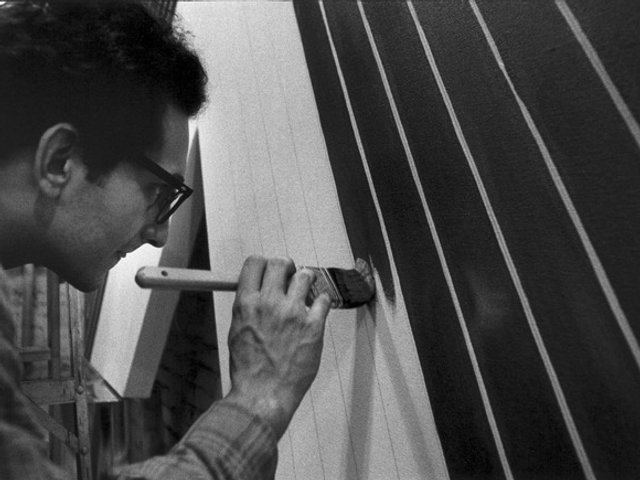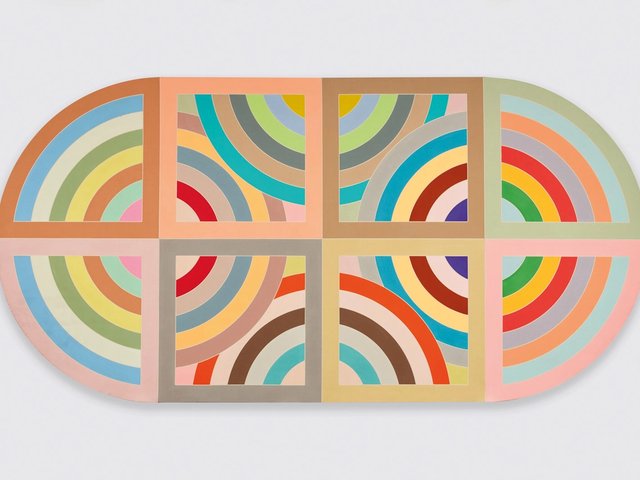Frank Stella, a towering figure in the field of abstract art for the past 65 years, has died, aged 87. His death on 4 May, at home in New York City, was announced by Marianne Boesky Gallery, which has represented Stella since 2014.
The gallery paid tribute to how Stella's "extraordinary, perpetually evolving oeuvre investigated the formal and narrative possibilities of geometry and colour and the boundaries between painting and objecthood". “It has been a great honour to work with Frank for this past decade,” Marianne Boesky said. “His is a remarkable legacy.”
Stella was 23 and had been painting in New York City for a year when he made a knockout debut on the city's art scene in 1959 with his austere striped monochrome Black Paintings series (1958-60), created using black household enamel paint, with fine parallel lines created where the canvas is left bare. They were shown, on loan from the recently launched but already influential Leo Castelli Gallery, in the historic Sixteen Americans (1959) show at the Museum of Modern Art (MoMA), alongside works by artists his senior in age including two who had already been shown by Leo Castelli, Robert Rauschenberg and Jasper Johns. (The museum acquired Stella's 1959 painting The Marriage of Reason and Squalor, II from the exhibition.) Stella's hope for the Black Paintings was that his audience would see the images without illusion, with paint laid down to a regular width (that of a household decorator's brush) "all at once", rather than as component parts.
To this austere, pristine, monochrome aesthetic Stella added first metallic hues and then bright colours, in a wide range of geometrical configurations—he showed his first shaped canvases, the Aluminium series, in 1960 at what was also his first one-man show, at Castelli. In the first decade or so of his life in New York, Stella had his work featured in several other landmark exhibitions at the city's leading institutions: Geometric Abstraction (1962) at the Whitney Museum of American Art, The Shaped Canvas (1964) and Systemic Painting (1966) at the Solomon R. Guggenheim Museum, and the Structure of Color at the Whitney in 1971.
Stella was born in Malden, Massachusetts, seven miles north of Boston city centre in 1936, and grew up there and in the neighbouring town of Melrose. He had come straight to New York, working as a house decorator to pay his way, after studying painting first with Patrick Morgan (a short story writer and artist, who had studied with Hans Hofmann) at Phillips Academy in Andover, Massachusetts, and then with the art historian William Seitz and the New York abstract artist Stephen Greene at Princeton University, from which he graduated in 1958. In 1959, Stella took part in group shows at Oberlin College, Ohio, and in New York at Tibor de Nagy Gallery and Leo Castelli before his MoMA debut in Sixteen Americans.
The MoMA retrospectives
In 1965, in company with Rauschenberg, Johns, Claes Oldenburg and Jim Dine, Stella was chosen to represent the United States at the Venice Biennale. Stella's Protractor series, brilliantly coloured large-scale semi-circular canvases named after the geometry tool of the same name and launched at Leo Castelli in 1967, cemented his influence on abstract art of his time. In 1970 he became the youngest artist, at the age of 33, to receive a survey at MoMA. His second survey exhibition at the museum, Frank Stella: Works from 1970 to 1987 (1987-88), started its chronological sequence with Stella's Polish Village series, dedicated to synagogues destroyed in Poland by the Nazis during the Second World War. This series was the first in which he moved from low-relief collage to making high-relief works using felt and cardboard.
"The relief paintings forced me to go out and get involved in the real world," Stella told The Art Newspaper in 1999. "I had to go out to buy felt and plywood and honeycomb aluminium and things like that. I started to bring things into my work, rather than work with things in the controlled conditions of the studio. Picasso went out quite a bit, but, by our standards, one would say that he did not so much go out as he went far with his materials."
Looking back at that era in 1999, a year in which he had a sculpture show at Bernard Jacobson in London, Stella said "I have outgrown or outlived the dealers [of the 1960s]. Larry Rubin is retired; Leo Castelli is gone [he had died the same year]. I actually grew up in a different generation and they are all gone now. My world is past and gone. I’m out there hassling to keep going, but I do not really fit into the hard world."

Frank Stella during his 2012 restrospective at the Kunstmuseum Wolfsburg, in Germany Frank Stella/Artists Rights Society (ARS), New York. Photograph: Matthias Leitze/Alamy Stock Photo
Stella graduated into working on large-scale sculpture and to collaborating with architects including Richard Meier—a friend of 65 years with whom Stella worked on the Federal Courthouse in Phoenix (opened 2000), the Museum of Contemporary Art in Barcelona (1995), the Weishaupt Forum (1993), near Ulm, in southern Germany and the Jubilee Church in Rome (2003)—and Santiago Calatrava. The Michael Kohlhaas Curtain (2008) is a 30-metre-long Stella banner painting wrapped round a Calatrava-designed ring-shaped frame.
A concern with the history of painting
In 1983-84 Stella gave the Charles Eliot Norton lectures at Harvard University, Working Space (published under the same title by Harvard in 1985), in which he commended baroque and other painting for its poetic, as well as constructive, use of space and volume. When, in 2017-18, he was the subject of Frank Stella: Experiment and Change at NSU Art Museum, Fort Lauderdale, a survey featuring more than 300 works, both Stella and the show's curator, Bonnie Clearwater, reflected on the artist's concern with the history of painting.
As a student, Stella had seen a Netherlandish painting at the Philadelphia Museum of Art, Rogier van der Weyden’s Crucifixion Diptych (around 1460). “It was a perfect example of what you should be trying to do, or what art should try to be,” Stella said. In the exhibition catalogue Clearwater wrote that Stella's engagement with the Van der Weyden indicates “the visual power of painting was a more important goal for him than following the rules of Modernism”.
Stella's first wife, Barbara Rose, became a leading art critic and author of "ABC Art", a 1965 essay for Art in America that helped to define Minimalism. In that essay, Rose wrote that the “self-effacing anonymity” of New York artists of the era, such as Donald Judd, Robert Morris, and her then husband Stella (they divorced in 1969), could be seen “as a reaction against the self-indulgence of an unbridled subjectivity, just as one might see it in terms of a formal reaction to the excesses of painterliness”.
'What you see is what you see'
Stella was famously direct in discussing his art. His much-referenced remark “what you see is what you see” was addressed to the art historian Bruce Glaser. “That doesn’t leave too much afterwards, does it?” asked Glaser. “I don’t know what else there is,” Stella replied. Speaking to The Art Newspaper half a century later, he remarked: "I’ve said it many times: abstraction can be a lot of things. It can, in a sense, tell a story, even if in the end it’s a pictorial story."
Speaking to the art historian Norbert Lynton for The Art Newspaper in 1999, Stella reflected on public perception of his work in the first 40 years of his career: "People say, 'Why do you change?' I do not change all that much. The changes really come from two things: one, being a little bit dissatisfied; the other being a little bit hopeful, looking for something else. Everyone wants you 'to find yourself', to have a style. That is great when it happens, but, by and large, artists want to keep looking."
A champion of new technologies
Stella was a noted pioneer of new technologies and worked with computer-aided design (CAD) and 3D printing from the late 1980s. In the mid-2000s, The Art Newspaper reported, Stella used a 3-D printer to produce metal and resin segments for his polychrome sculpture series Scarlatti Kirkpatrick, inspired by the harpsichord sonatas of the 18th-century Italian composer Domenico Scarlatti, and the writings of the 20th-century American musicologist Ralph Kirkpatrick.
The 3D printing technology, Ron Labaco, a curator at the Museum of Arts and Design in New York, told The Art Newspaper in 2013, gave Stella “an opportunity to project work out from the wall in a way that would have been difficult, and too heavy, using traditional means”. Labaco featured Stella’s work in an exhibition devoted to computer-enabled pieces, Out of Hand: Materialising the Postdigital (2013-14).
When Stella minted his first NFT (non-fungible token), for his project Geometries, in 2022, he collaborated with the Artists Rights Society (ARS)—founded in 1987, to represent artist rights through copyright, licensing, and monitoring visual artists in the United States—a connection that reflected Stella's involvement with and support of ARS. "We sold out all 2,100 tokens," Katarina Feder, director of business development at ARS, told The Art Newspaper, "and, importantly, brought in resale royalties for secondary sales, something that Frank has been championing for decades."
The ARS, through its digital arm ARSNL, reached out to NFT collectors by publishing a process video and curatorial statement by the art analytics expert Jason Bailey. "These digital collectors fell in love with Frank and his work," Feder said, "and many of them created their own derivatives, something that Frank allowed for. We showed some of these to Frank and he loved them." The NFT drop appealed to Stella, as he told the NFT magazine Right Click Save, because "in a very abstract way [NFTs] seem like a possible way to solve some of the issues that come from ever-increasing reproducibility caused by technological progress in imaging and fabrication. But more concretely, they may be a way for artists to seize the resale rights that I want us to have."
Stella's very open approach to the NFT drop, in which the artist proposed that collectors have the right to create derivatives and the right to 3D print the artwork, helped solidify his legacy as a painter’s painter. "As much as Stella has cared for material, physical form and surface, he has cared for the rights of his fellow artists," Gretchen Andrew noted in her Art Decoded column for The Art Newspaper. "For decades he has been lecturing and lobbying for the cause of resale rights."
The Stars series
One of Stella's best-known series of his later career is Stars: large, multi-pointed stars in the round. One pair, seven metres tall, featured in the courtyard of the Royal Academy in London in 2015. In 2021, Stella installed the stainless steel Jasper’s Split Star in the plaza of 7 World Trade Center in New York City. The work was a symbolic replacement for a diptych of large paintings by Stella—Laestrygonia I and Telepilus Laestrygonia II, each ten feet tall by ten feet wide—that had hung in the lobby of the original 7 World Trade Center, destroyed in the 9/11 attacks on the city 20 years previously.
By the time of his 2015 retrospective at the Whitney—an exhibition that inaugurated the museum's new multilevel building by the High Line—Stella no longer carried the burden of Minimalism that he had assumed with his Black Paintings. “I feel that one of the nice things about outgrowing everything is that it’s up to everybody else now,” he told The Art Newspaper.
Frank Philip Stella, born Malden, Massachusetts 21 May 1936; married 1961 Barbara Rose (died 2020; one son, one daughter; marriage dissolved 1969); partner of Shirley De Lemos Wyse (one daughter); married secondly Harriet E. McGurk (two sons); died New York City 4 May 2024.
Read more of Frank Stella in his own words from The Art Newspaper archive.







